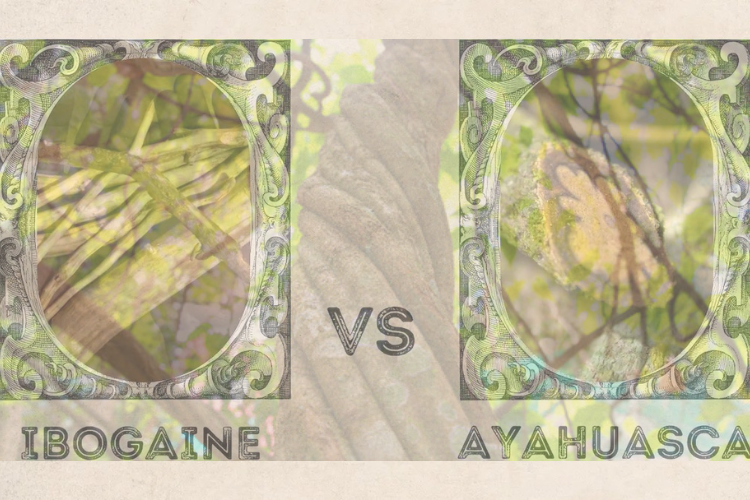
Ibogaine vs. Ayahuasca – What You Need to Know
You’re deep into your research about the best psychedelic retreat for you. You’ve gotten pretty familiar with ayahuasca from pop culture, friends, Burning Man, and every psychedelic enthusiast in your favorite Facebook group. As you conduct your research, other, often more potent, plant medicines are popping up. How should you compare these other medicines to ayahuasca? Are they worthy of consideration? Many psychonauts who try ayahuasca also find ibogaine useful. But how do you compare ibogaine vs. ayahuasca? Let’s better understand ibogaine, compare it to ayahuasca, and help you decide which one is best for you.
Table of Contents
What is Ibogaine?
Ibogaine is the hallucinogenic root of a West African shrub called Iboga. Although psychedelic enthusiasts around the world are only beginning to take notice, the indigenous peoples of Western Africa (specifically in Gabon) have been using it for centuries. The Bwiti tribe, whose administration of ibogaine has become the template for modern western retreat operators, used it as an initiation rite for young men. Smaller quantities are also consumed for healing ceremonies.
Ibogaine is heralded as a medicine of last resort for people suffering from severe addiction. It can be used very effectively as a remedy for mental health issues such as depression and anxiety. However, ibogaine is not without risk and has been associated with some fatalities.
Ibogaine vs. Iboga: What’s the Difference?
Iboga refers to the root of the shrub itself. Ibogaine is the active component of iboga; it can be extracted and taken on its own. Ibogaine passes through the system more quickly than iboga, which means a shorter recovery period after ingestion. Ibogaine consumers may feel hyperactive afterwards, whereas iboga is known to leave its consumer more calm.
Another difference between iboga and ibogaine is legality. Ibogaine is considered a schedule I drug in the USA, putting it on the same level of legality as heroin. However, it is legal in Canada and unscheduled in Mexico (a grey area that enables ibogaine retreats to operate despite some risk).

What is Ayahuasca?
Ayahuasca is a psychedelic brew concocted from the bark of a vine native to the Amazon basin and several other herbs and plants. Indigenous people have been using it for centuries; some evidence suggests its use dates back as far as 2000 BC. Historically, ayahuasca has also been used in initiation rites for males coming of age, and it was and continues to be used in healing ceremonies as well.
In Canada, ayahuasca is completely illegal to possess, sell, transport, or cultivate. In the USA, it is classified as illegal unless being used for religious purposes. However, it is fully legal (or unscheduled, leaving it in that grey area again) in Mexico, Costa Rica, Peru, and Brazil.
Ibogaine vs. Ayahuasca: Similarities
While they come from completely different continents, the similarities between these two plant-derived substances are considerable. For starters, Ayahuasca and ibogaine are both psychoactive substances made from plants. They are both used in indigenous traditions. Despite the fact that the Amazonian and West African people did not have any contact, the substances have been used in strikingly similar fashion in coming-of-age rituals for young men.
They are both lauded for their healing properties. Neither is a recreational substance; the experience produced by both ibogaine and ayahuasca is intense and physically challenging. Both can induce vomiting, and ayahuasca in particular is known for making its users purge liquids from various bodily orifices. However, in both cases, purging is viewed as a part of the spiritual experience associated with that substance.
Finally, both ayahuasca and ibogaine have been used successfully to banish or diminish addiction, although ibogaine is currently more well-known for its anti-addictive effects.
Ibogaine vs. Ayahuasca: Differences
There are also a few key differences between ayahuasca and ibogaine and they aren’t trivial!
Ayahuasca is relatively much safer than ibogaine. Ibogaine is used in a clinical setting to treat addiction and you are much more likely to be treated by trained medical practitioners. While a number of fatalities have been associated with ibogaine consumption, serious ayahuasca complications and deaths are exceedingly rare.
Ibogaine is primarily used as a treatment for addiction (though it can be more broadly helpful), while ayahuasca is used for a wider variety of conditions and purposes. Applications range from the promotion of brain health and psychological wellbeing to treatment for mental health conditions such as anxiety, depression, post-traumatic stress disorder, and others. Some consumers take ayahuasca for a more loosely-defined need for change.
User Experience
The experience of taking ibogaine vs. ayahuasca is also quite different. An ibogaine trip lasts from 18-24 hours, taking effect 1 – 3 hours after consumption. The first phase of the journey is the most acute. It has been described as a “waking dream state” with a floating sensation accompanied by memories experienced as a panoramic visualization. Vomiting, nausea, and other unpleasant sensations also sometimes occur. This first phase lasts 4 – 8 hours. The second phase entails deep introspection and reflection. Users will still feel the effect of ibogaine during this part of the journey. After the trip finishes, some people find that their energy and libido are heightened for anywhere from a few days to a few weeks.
Ayahuasca is shorter-acting, with the whole experience usually lasting only 4 – 6 hours, although it can go as long as 12. The journey varies from person to person, generally described as intense and spiritual and is known to induce mystical revelations about the nature of reality. These epiphanies can bring about a personal understanding of one’s purpose as well as insights on how to transcend difficulties and become a better version of oneself. Some claim to have accessed different planes of existence or made contact with benevolent beings in other dimensions who aid in the healing process.
Sounds pretty great, right? It can be, but the journey is far from easy. You’ll probably vomit, have diarrhea, cry, shake, and sweat. Furthermore, an ayahuasca trip often involves the dredging up of old, traumatic memories, although ultimately, this allows them to be processed and released.
The Verdict
Safety is key, and unequivocally, ayahuasca is safer than ibogaine, so we’re compelled to recommend that you try it first. However, if you are dealing with issues of addiction that you haven’t been able to shake (and that addiction brings its own personal danger), you should consider ibogaine above ayahuasca, as it may more directly help you overcome this acute danger. In either case, you will want to do your homework on the practitioners, and as always, please consult your doctor!
Want to learn more about Ibogaine and the Treatment Centers that offer it? Then check out our Ultimate Ibogaine Treatment Center Guide!
Related Articles
Learn more about Ayahuasca on Frshminds:
- The Ultimate Ayahuasca Retreat Guide
- Must Read Info About Ayahuasca Retreats in Peru
- What is the Difference Between Ayahuasca and DMT?
- Join Your Peers on Ayahuasca Retreats In Spain
- 10 Best Ayahuasca Documentaries in 2022
- What is The Ayahuasca Preparation Diet?
- 10 Ways to Prepare for an Ayahuasca Retreat
- Journey Within: A Guide to Ayahuasca Retreats in Costa Rica

Comments